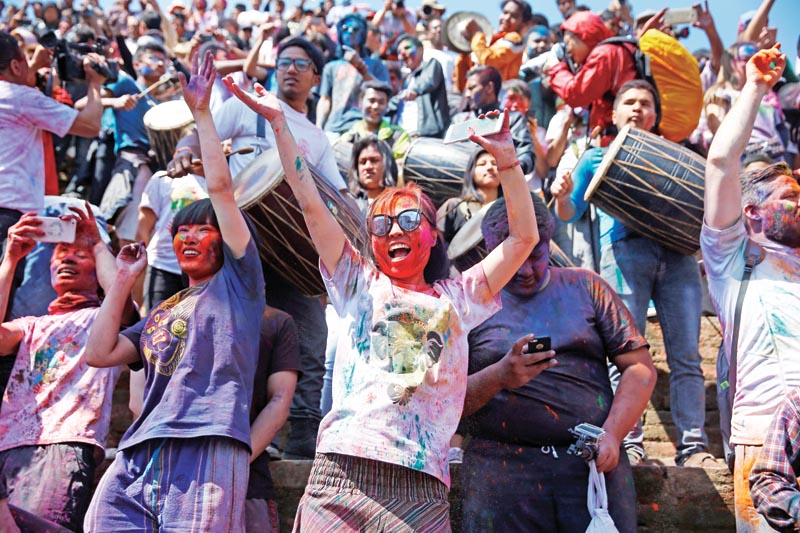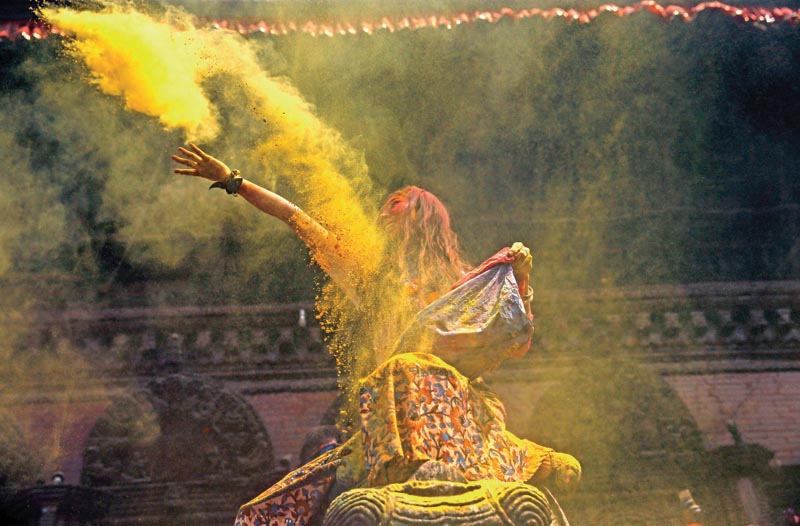Changing colours of holi
Kathmandu
Until some years back young boys targeting girls and women with lolas, girls trying to dodge the attack and walking on the streets amidst fear was a common scene, at least a week prior to Holi.
The scene is changing gradually, as people nowadays can walk in a relaxed manner even a day before Fagu Purnima — a significant change in the way this festival of colours is celebrated. As Nepalis gear up to celebrate the colourful festival this year — on March 1 (in Hilly regions including Kathmandu) and March 2 (Tarai region), some revellers share the festival’s significance for them while contemplating on its changing colours.
Reduced terror and mischief
Gyanu Gurung Raut, 26 associates Holi with terror though she doesn’t celebrate the festival. When she was a child, boys used to ruin her uniform either by splashing water or throwing colours on her.
“Girls were the targets” and she always needed company to travel when the festival neared. “It was extremely annoying during that time, there was no restriction. People were inconsiderate and did not care whoever it was or where they were heading to. Selling of balloons and other activities began more than 15 days earlier.”
She is glad that things have changed now. “It’s comparatively safer being a pedestrian but still, crimes and alcohol abuse needs to be controlled,” she opines.
But it’s a ‘Nursery prank’ that Prasun Pahadi recalls when asked about his Holi memory. “I was probably around four years old then. I wasn’t allowed to run around like other children. So, I once hid quietly on my terrace with lots of water balloons. There was an elderly woman sitting on my neighbouring terrace, and applying oil on her body (which I realised many years later). I hit her with the balloon. I was so proud of myself until I got spanked,” he remembers.
No more he feels the same thrill about the festival. “It has already been around five years since I last celebrated Holi. Maybe it’s how the excitement wanes as you grow up.”
The Holi excitement, however, is still intact for 19-year-old Anshuka Rani Das despite some bad memories. That is why she celebrated the festival even in China. Das, who is currently pursuing her higher studies in Clinical Medicine in China, celebrated last year’s festival with her friends from Pakistan, Sri Lanka, Russia, Indonesia, China and Malaysia.
“We managed to find colours and celebrated the way we used to do in Nepal — smearing colours among friends and running around our university like clowns,” Das recalls the festive mood.
Initially she had imagined that being away from home for the first time on the day of Holi would be traumatic since she had gone through such an experience as a child: “When I was young, someone hit my cousin sister with a balloon filled with stones and filthy water. A big piece of stone hit her head and she started bleeding. Other pebbles hit her in the eye. We spent that Holi in hospital while our parents relentlessly searched for the culprit. My cousin took about a week to recover.”
For Anjum Gurung, 21, from Pokhara “the colours of Holi signify blooming flowers of Spring and I love this concept”. Sadly, she can’t enjoy festive colours as she started developing allergies to the powdered colours in her late teens. And she too has a bad experience to share.
In 2014, her hostel warden’s son splashed her with a huge bucket of coloured water and she developed allergies all over her body. “Back then, the rules were not that strict during Holi, especially in Pokhara,” she adds.
Not the same
Sita Pant, 30, a homemaker from Mahendranagar who resides in Lalitpur says Holi does not feel the same here (Capital). During her childhood, they did not need calendars to mark this celebration. Instead, fading away of hazy days and a brighter sun meant a splash of water balloon on your dress! (And, running back home to get a bucket of water for responding the attackers.)
“Holi used to be crazier than Dashain or Tihar and was observed for days, back then. Evenings before the festival meant forming groups, visiting homes nearby, performing our Fagu Naach ( similar to deusi or bhailo of Tihar) and collecting money and rice from many houses,” Pant recalls.
Nowadays, the celebration is a bit different. Sakar KC, an undergraduate student from Capital has never missed a single Holi celebration yet. And for him, the day is all about friends, family, water attacks, colours and delicious food. His day begins with little pranks with his cousins and he’s all prepared to make the most of the day donning proper outfit.
As a child, he used to prepare for the main day at least a week before the Holi. But the festival has lost its charm these days as it ends within a few hours, as per KC.
Since the past few years, the Government has been warning revellers against unruly behaviour during Holi. Is it the strict rules that has affected his Holi celebrations?
KC argues, “I am fine with the implementation of strict rules on Holi. But the authorities concerned should also create a suitable environment for a peaceful celebration of the festival at appropriate location with proper security and traffic management.”
Celebratory shades
Holi adds up to our plain dull lives and just like our diverse topography, culture, traditions and the celebrations do differ from place to place.
Aryan Bimali, a photographer from Sarlahi, residing in Kathmandu prefers “playing Holi in my own locality but sometimes I like being around Basantapur area because it is fun there.”
But nothing beats the way it is celebrated in his hometown Sarlahi. He shares, “We use more colours than water in Sarlahi. People don’t force others to enjoy along with them and maintain boundaries. There’s no use of balloons. And the best part is relishing Ghatta — a drink made of milk, fruits and hemp. It makes people laugh a lot.”
For Holi enthusiast Biraj Thapa, an undergraduate student from Hetauda, “enjoyment is all that defines Holi”. He justifies with an instance: “Around two years back, one of my friends tore my shirt as he was indulged in the celebration, and I had to roam around the city for three hours without my shirt on. I was embarrassed but it was fun.”
Holi celebration has been growing over the years in Hetauda. “People don’t overdo and stay within their limits and follow rules. People have been limiting celebration to their known circles and do not affect other’s privacy which is good,” he shares.
Social activist Bimochan Poudel, like other residents of Chitwan celebrates Holi for two days as “people from many districts of the country have migrated to this area”. The undergraduate student also adds that the students usually start celebrating three days prior to the main day. He reveals, “Families and friends gather, exchange greetings and usually the river banks are crowded during Holi celebration. Many concerts and other events are also organised. This community has a particular love for Ghatta.”
And the festival has also transformed a lot over the years. “It has modernised. The special songs and dances that used to be performed for Holi are rare these days. The use of harmful colours has been stopped. Importantly, there are strict rules regarding drinking and driving, unwanted fights and forceful celebrations,” Poudel claims.
Sadhana Mehta, a student briefed about Holi celebration in Janakpur. “Here, it’s about getting blessings from elders. We observe Holi for one day, but prior to the day there is Holika Dahan — evening bonfires are lit up to celebrate Prahlad’s victory (over his aunt Holika). People gather around, enjoy their favourite dishes like Dahi Vada, puri, Selroti and soft drinks. It is a time of reunion.” Celebrations too are comparatively safer than the past probably because “people have become more civilised as well as educated”.
But Babita Gurung, a school teacher in Jhapa, associates Holi with freedom of women. Gurung, who celebrated Holi for the first time in 2017, was surprised when a young group of women came to her house with an invitation to join them.
“I was contented to see women relaxing in such a way as women in our country are hardly seen enjoying Holi so freely,” she says adding that Holi not only denotes the triumph of good over evil but also reflects the state of freedom of expression.
Gurung believes that this celebration of colours remarks ecstasy, happiness, unity, renewal and triumph.
Even though it is a one-day celebration, Holi memories are what we carry for a lifetime. Make sure you have no shoddy remembrance of the day and play safe.







